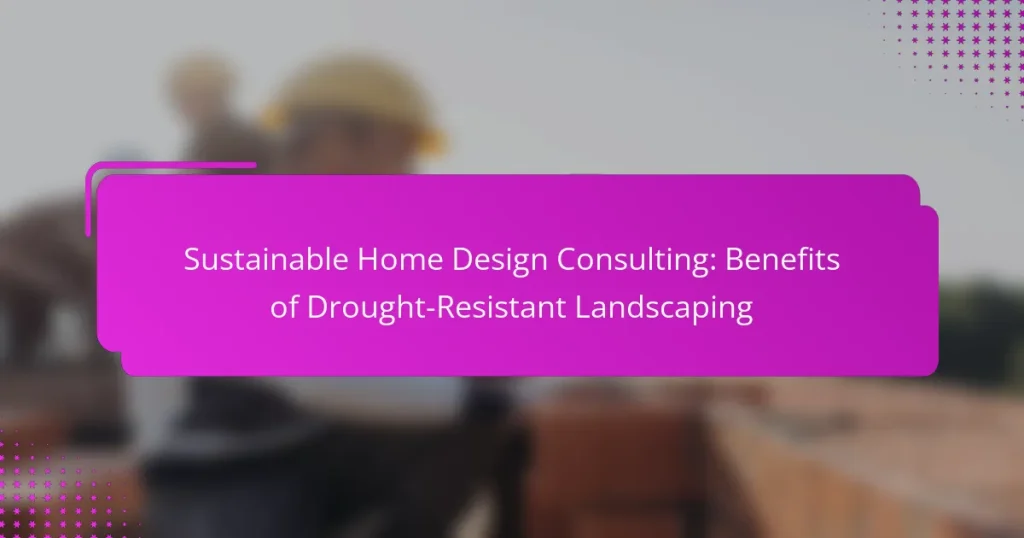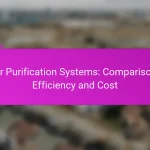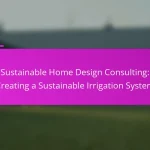Drought-resistant landscaping is a key component of sustainable home design, offering significant benefits such as water conservation and reduced maintenance. By selecting appropriate plants and design techniques, homeowners can create visually appealing gardens that thrive in dry conditions while promoting environmental sustainability.
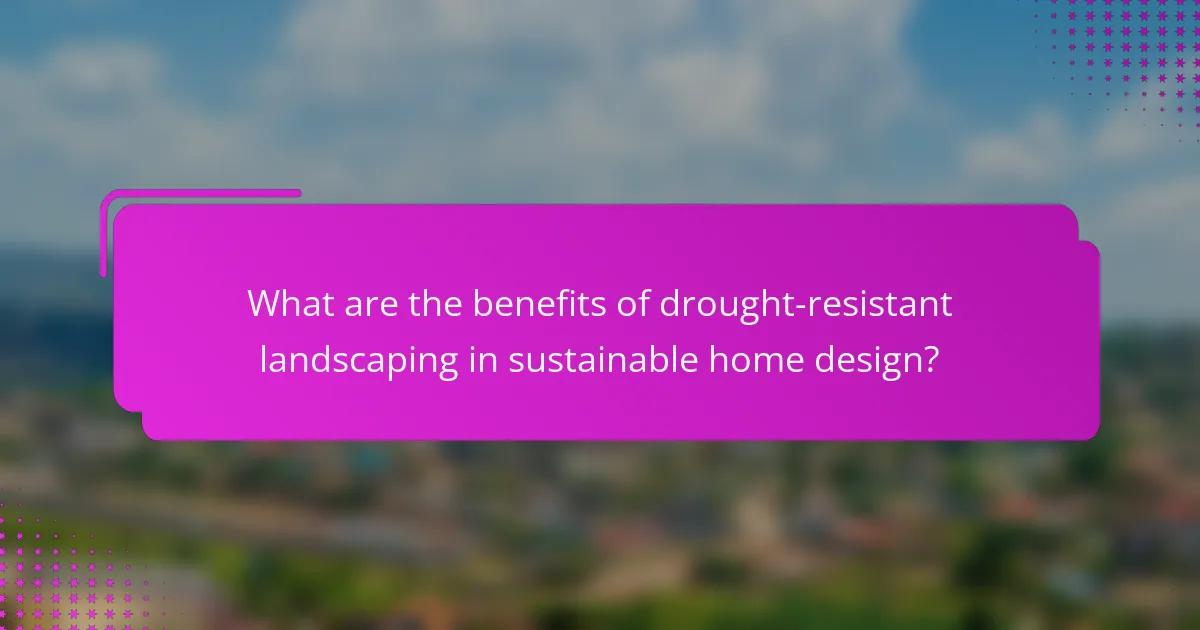
What are the benefits of drought-resistant landscaping in sustainable home design?
Drought-resistant landscaping offers numerous advantages in sustainable home design, primarily by conserving water and reducing maintenance needs. This approach not only enhances the aesthetic appeal of properties but also contributes to environmental sustainability.
Water conservation
One of the most significant benefits of drought-resistant landscaping is its ability to conserve water. By using native plants and xeriscaping techniques, homeowners can reduce their water usage by up to 50% compared to traditional landscaping. This is especially crucial in regions prone to drought, where water resources are limited.
Implementing efficient irrigation systems, such as drip irrigation, can further enhance water conservation efforts. These systems deliver water directly to the plant roots, minimizing evaporation and runoff.
Reduced maintenance costs
Drought-resistant landscapes typically require less maintenance than conventional gardens, leading to lower long-term costs. Native plants are often more resilient and better adapted to local conditions, which means they need less frequent watering, fertilizing, and pest control.
Homeowners can save on landscaping services and materials, as these gardens often thrive with minimal intervention. This can result in savings of hundreds of dollars annually, depending on the size and complexity of the landscape.
Enhanced property value
Investing in drought-resistant landscaping can significantly enhance property value. Homes with sustainable features, including water-efficient gardens, are increasingly appealing to buyers who prioritize environmental responsibility.
Research indicates that properties with well-designed drought-resistant landscapes can see an increase in resale value by 10% or more, making it a smart investment for homeowners looking to maximize their property’s worth.
Improved biodiversity
Drought-resistant landscaping promotes biodiversity by providing habitats for local wildlife. By incorporating a variety of native plants, homeowners can attract beneficial insects, birds, and other wildlife, which contribute to a balanced ecosystem.
Creating diverse plantings not only supports local fauna but also enhances the resilience of the landscape itself, making it more adaptable to changing climate conditions.
Climate resilience
Landscapes designed with drought-resistant principles are better equipped to withstand climate fluctuations. These designs often include features that improve soil health and reduce erosion, making them more resilient to extreme weather events.
By prioritizing native and drought-tolerant plants, homeowners can create landscapes that thrive under varying conditions, reducing the need for additional resources and interventions during periods of drought or heavy rainfall.
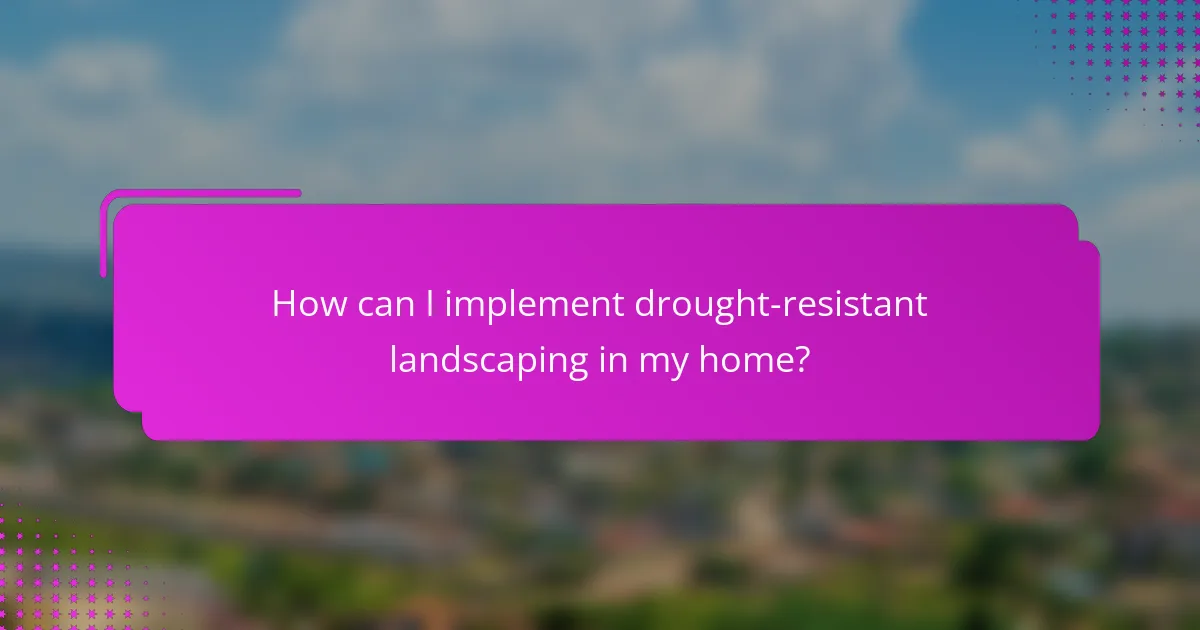
How can I implement drought-resistant landscaping in my home?
Implementing drought-resistant landscaping involves selecting plants and design techniques that minimize water usage while maintaining aesthetic appeal. This approach not only conserves water but also enhances the resilience of your garden against dry conditions.
Choosing native plants
Native plants are well-adapted to local climates and require less water and maintenance compared to non-native species. When selecting plants, consider those that thrive in your region’s specific conditions, such as soil type and rainfall patterns.
Examples of drought-resistant native plants include lavender, sage, and various succulents. These plants not only survive with minimal watering but also support local wildlife, enhancing biodiversity in your landscape.
Utilizing xeriscaping techniques
Xeriscaping is a landscaping method that reduces or eliminates the need for irrigation by using drought-tolerant plants and efficient design strategies. Key principles include grouping plants with similar water needs and using mulch to retain soil moisture.
To implement xeriscaping, start by assessing your yard’s sun and shade patterns, then design your garden layout accordingly. This approach can significantly lower water bills and reduce environmental impact.
Incorporating efficient irrigation systems
Efficient irrigation systems, such as drip irrigation or soaker hoses, deliver water directly to the plant roots, minimizing waste. These systems can be programmed to water during cooler times of the day, further reducing evaporation.
Consider installing a rainwater harvesting system to collect and utilize rainwater for irrigation. This not only conserves municipal water supplies but can also lower your water costs, making it a sustainable choice for your home landscaping.
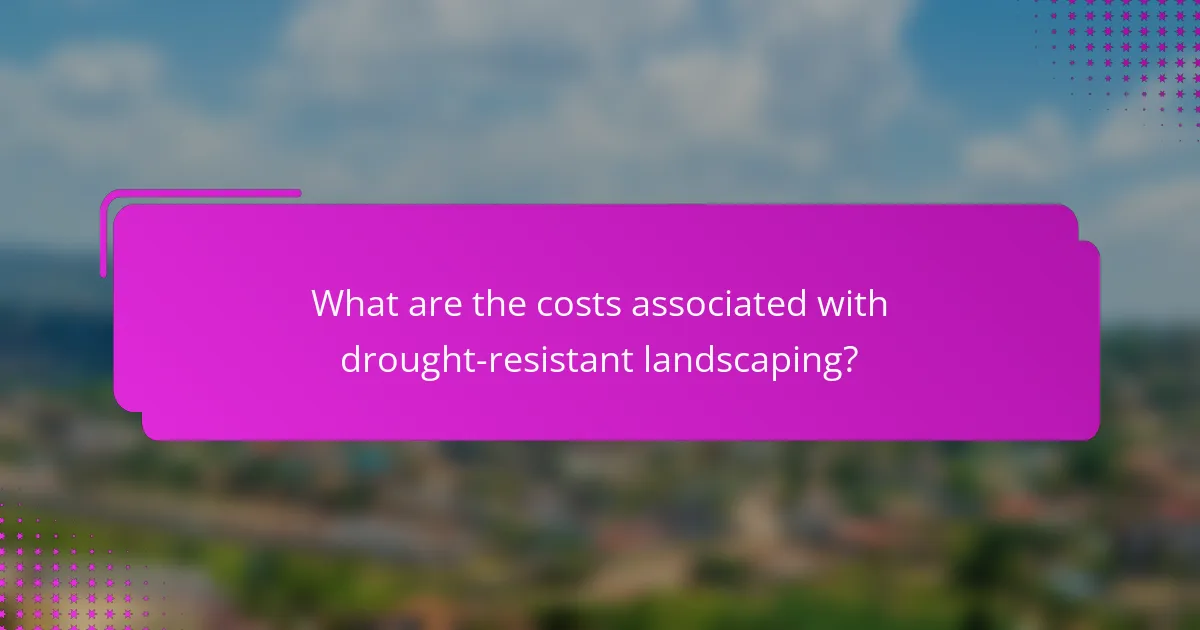
What are the costs associated with drought-resistant landscaping?
The costs associated with drought-resistant landscaping can vary widely based on design choices, plant selection, and installation methods. While initial expenses may be higher than traditional landscaping, the long-term savings and benefits often outweigh these upfront costs.
Initial installation costs
Initial installation costs for drought-resistant landscaping typically range from a few thousand to several thousand dollars, depending on the size of the area and the complexity of the design. Factors such as soil preparation, plant selection, and hardscaping elements like pathways or patios can significantly influence these costs.
Choosing native plants that require less water can help reduce installation expenses. Additionally, working with a landscape designer experienced in drought-resistant methods may lead to more efficient use of resources and better long-term outcomes.
Long-term savings on water bills
One of the most significant benefits of drought-resistant landscaping is the reduction in water bills. Homeowners can expect to save anywhere from 20% to 50% on their water costs, depending on the extent of their landscaping changes and local water rates.
By utilizing xeriscaping principles, such as grouping plants with similar water needs and incorporating mulch, homeowners can minimize water usage. Over time, these savings can offset the initial installation costs, making drought-resistant landscaping a financially sound investment.
Potential increase in property value
Drought-resistant landscaping can enhance property value by improving curb appeal and reducing maintenance requirements. Homes with well-designed, water-efficient landscapes often attract buyers who prioritize sustainability and lower upkeep costs.
Research indicates that properties with drought-resistant features can see an increase in value of 5% to 15% compared to those with traditional landscaping. This potential appreciation makes investing in drought-resistant landscaping not only environmentally friendly but also a smart financial decision.

What are the best practices for sustainable home design consulting?
The best practices for sustainable home design consulting focus on integrating environmentally friendly solutions that enhance energy efficiency and reduce resource consumption. Key strategies include assessing site conditions, collaborating with local experts, and using eco-friendly materials to create resilient landscapes.
Conducting site assessments
Site assessments are crucial for understanding the unique characteristics of a property, including soil type, topography, and climate. This information helps in designing landscapes that are not only aesthetically pleasing but also functional and sustainable.
During a site assessment, consider factors like sun exposure, drainage patterns, and existing vegetation. This data can inform decisions on plant selection and irrigation systems, ensuring that the landscape thrives with minimal water use.
Collaborating with local landscape architects
Working with local landscape architects brings valuable insights into regional plants and sustainable practices. These professionals understand local climate conditions and can recommend drought-resistant species that require less maintenance and water.
Collaboration also allows for the integration of local regulations and standards into the design, ensuring compliance and enhancing the overall sustainability of the project. Engaging with experts can lead to innovative solutions tailored to the specific needs of the site.
Utilizing eco-friendly materials
Choosing eco-friendly materials is essential for sustainable home design. This includes selecting native plants, permeable paving, and recycled or sustainably sourced materials that minimize environmental impact.
When selecting materials, consider their lifecycle, including production, transportation, and disposal. For instance, using locally sourced stone or reclaimed wood can significantly reduce carbon footprints while supporting local economies.
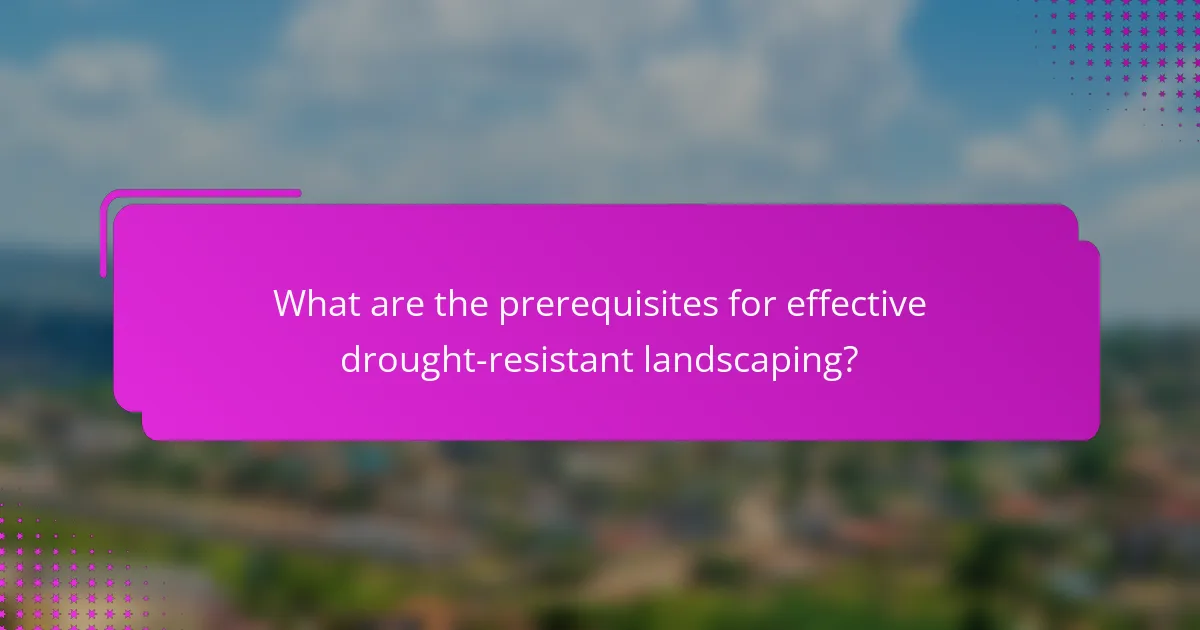
What are the prerequisites for effective drought-resistant landscaping?
Effective drought-resistant landscaping requires an understanding of local climate conditions and thorough soil analysis. These prerequisites help in selecting appropriate plants and designing a landscape that conserves water while thriving in arid environments.
Understanding local climate conditions
To create a successful drought-resistant landscape, it’s essential to assess the local climate. This includes understanding temperature ranges, precipitation patterns, and seasonal variations. For instance, areas with hot summers and mild winters may require different plant choices compared to regions with cooler climates.
Consider using local climate data to identify native plants that are naturally adapted to your environment. Native species typically require less water and maintenance, making them ideal for sustainable landscaping.
Soil analysis and preparation
Conducting a soil analysis is crucial for effective drought-resistant landscaping. Testing the soil will reveal its composition, pH level, and nutrient content, which informs plant selection and soil amendments. For example, sandy soils drain quickly and may require more frequent watering, while clay soils retain moisture but can become compacted.
Once the analysis is complete, prepare the soil by incorporating organic matter, such as compost, to improve its structure and water retention. This preparation enhances the soil’s ability to support drought-tolerant plants and reduces the need for supplemental irrigation.

How does drought-resistant landscaping compare to traditional landscaping?
Drought-resistant landscaping uses plants and design techniques that require significantly less water than traditional landscaping. This approach not only conserves water but also reduces maintenance and promotes sustainability in garden design.
Water usage efficiency
Drought-resistant landscaping is designed to maximize water efficiency by utilizing native and adapted plants that thrive in local climates. These plants often require minimal irrigation once established, making them ideal for regions prone to water shortages.
In contrast, traditional landscaping typically relies on high water usage, often requiring regular watering schedules and extensive irrigation systems. This can lead to increased water bills and may not be sustainable in areas facing drought conditions.
Maintenance requirements
Maintenance for drought-resistant landscapes is generally lower than for traditional gardens. Once established, these landscapes often need less frequent watering, fewer fertilizers, and reduced pest control measures, allowing homeowners to spend less time and money on upkeep.
Traditional landscaping, on the other hand, often demands regular mowing, watering, and fertilizing, which can be time-consuming and costly. Homeowners should consider these factors when choosing between the two approaches, especially in regions where water conservation is critical.
